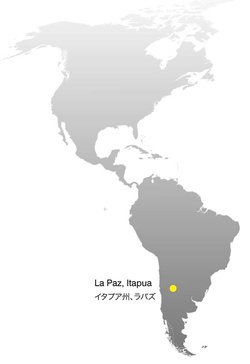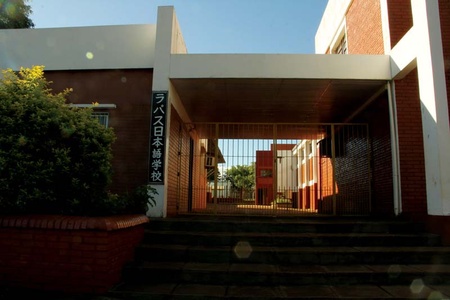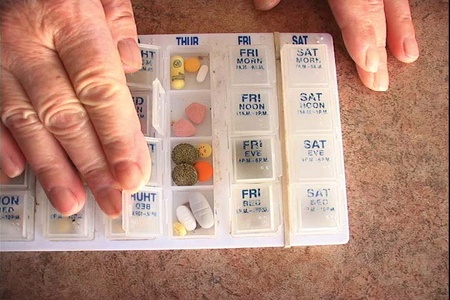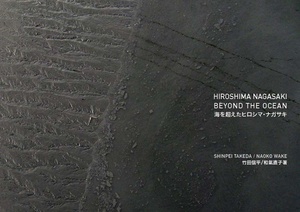4. Survivor's Destinations—South America
Paraguay
A country of striking red soil, Paraguay has rich, expansive fields that seem to reach the horizon. Bordering with Argentina, Brazil, and Bolivia, Paraguay also houses several Japanese colonias.
The La Paz resettlement in the Fram district is one of the newer Japanese colonias in South America. Like San Juan in Bolivia, the earliest Japanese immigrants arrived there in the 1950s. As elsewhere in South America, those who came to this small landlocked country—Paraguay’s population is 6.6 million—opened up primitive forests in order to create farmland. Not knowing the local languages, the first-generation immigrants exchanged their watches and other personal items brought from Japan for vegetables offered by the local Guarani natives. A majority of Japanese immigrants—by now mostly second and third generation—are still dedicated to agriculture. They farm soybeans, rice, nuts, fruit, and wheat, and some own large farms of over a hundred hectares.
Japanese cultural associations try to keep alive the heritage of Japanese language and culture, but their efforts seem to do little to slow the youths’ absorption into the Spanish-speaking community and their tendency to leave the Japanese community behind to move to urban centers.
Fusae Genda, one of two remaining survivors of Hiroshima in Paraguay, struggles to come to terms with the new reality of the younger generations.
Surrounded by her fourth son, his Paraguayan wife, and her half-Paraguayan, half-Japanese grandson, Genda quietly drinks Paraguayan mate tea. When finished, she returns the cup to her son, who fills it with mate leaf and ice-cold water infused with local herbs, then passes it to the next person in the circle. In Paraguay, drinking mate tea from the same cup is a sign of friendship, and whatever is discussed over tea would not be revealed even in a courtroom. That is how seriously people take the sharing of mate tea as a ritual of trust and intimacy.
Genda came to Paraguay in 1955. Since then, she and her husband have dedicated themselves to agriculture while raising eight children. With the help of her fourth son, she currently cultivates soybeans on some 300 hectares of farmland. Her story of the bomb begins with the loss of her sister, followed by more deaths in her family.
When the bomb was dropped, Genda was working at a shoe factory as part of the mobilized student corps. The factory was shattered, but she was able to crawl out of the rubble. Fortunately, she had only slight injuries, and she immediately took refuge in a relative’s house. A few days after the bombing, she was at another relative’s house along with her older sister. Genda was thirteen at the time, her sister fifteen. She witnessed her sister vomit blood and die, despite all her efforts to provide care. She remembers the incredibly large quantity of blood, and the lack of any medicine to help her sister.
When she attempted to return home, Genda found out that her house had been destroyed and that both her father and mother were dead. They had been severely burned, she was told. She also found her younger sister, burned to death in a closet. Another one of her older sisters died from radiation. Her older brother, too, was soon killed, having been crushed under heavy machinery while working at his factory. Ultimately she lost everyone but her younger brother to the bomb. Her older brother, her two older sisters, her younger sister, and her parents were gone.
Genda says that she does not want to see any more deaths. Three years ago, her husband, whom she had married soon after the war, passed away. As a young couple with young children, they had applied for a resettlement program in Paraguay, which turned out to be nothing like what they expected. Upon arrival they were given a thickly forested plot, where they started their new life by putting up tents, cutting trees, and opening up the land. They had no prior knowledge of Paraguayan culture or language. Genda remembers that she used to buy a sack of old rice and cook it with yuca (mandioca) while fighting off snakes and bats in the house.
There is a graveyard on the outskirts of the town. From that vantage point one looks around and sees nothing but farmland extending all the way to the horizon. In the graveyard lie several tombstones with “Genda” inscribed in Japanese. This is where Genda’s husband rests. She cleans the tombstones, brings flowers and burns incense, and prays. At this moment, she seems content to live out her life in this Paraguayan village called Yamatomura, far from her first home in Japan but close to her husband.
5. Remaining Scars
PHYSICAL ILLNESS

Many survivors are constantly concerned about their health. When they left Japan after the war, hibakusha techo certificates had not yet been widely distributed, and little was known about the health effects of radiation. Thus, radiation illnesses were not recognized as such. Moreover, there was no open discussion about the effects of the atomic bombs and radiation in Japan at the time.
After all, it was only in 1952 that the occupation forces left Japan and lifted press censorship. Until then, the mass media were not allowed to report in depth on what had happened in Hiroshima and Nagasaki. Then, in 1954, the tide shifted. The Japanese fishing boat Lucky Dragon Five and its crewmembers were exposed to a fatal quantity of radioactive fallout from the American nuclear test site on Bikini Atoll. The Japanese public for the first time became keenly aware of the horrors of radiation, which triggered the beginning of the antinuclear movement in Japan.
When survivors of the bomb left Japan, however, they were largely cut off from information from Japan. Unlike today, nothing was accessible via the Internet or television. Only in the 1970s, when hibakushas living abroad became widely known for a series of lawsuits concerning their healthcare benefits, did attitudes start to shift. Until then, many did not even think about the correlation between their ill health and the radiation to which they had been exposed years ago. This does not mean, of course, that survivors did not often fall sick and live lives of constant worry about what would happen next before the 1980s; many did.
In Sue Carpenter’s case, she was sent from one department to another in a navy hospital for examinations of her numerous symptoms. When she finally told the physician that she was in Nagasaki during the atomic bombing, he told her to go to the hospital in Japan that specialized in bomb-illness. Far from being able to escape the place of trauma, then, she was forced back into it.
6. Initiatives
Survivors in South and North America have lived through new challenges in new circumstances. They have grappled with numerous worries and health problems, showing a determination to survive and to protect their families. Now that they are in their seventies, eighties, and even nineties, they have finished raising their children and in some cases their grandchildren, and many have retired from work as well. Some seem to have finally found the tranquility for which they have longed. In this phase of their lives, however, their memories of the atomic bombs from some sixty years ago often re-emerge. In an attempt to deal with their memories, which they have kept inside for so long, many survivors have chosen to act.

for a radio broadcast in Tijuana, Mexico (August 2008)
Some have revealed their experiences to their families for the first time. Some have spoken for the first time to journalists or scholars. Some have started to share their experiences with members of their local communities in their local languages. Some have decided to take their children or grandchildren to the Hiroshima Peace Memorial Museum or Nagasaki Atomic Bomb Museum. Some have written books or memoirs about their experiences, so that they will not be forgotten. Some have formed survivors’ groups, creating safe places to gather and discuss their experiences.
While many have interacted with their surrounding communities, others have adopted other means to go deep inside their memories. Through poems, paintings, and other forms of art, they have explored and expressed what they feel about the atomic bombings. Still other survivors have been dedicated antinuclear activists and are acknowledged by local, national, and international communities.
Some of them have been widely recognized, like Setsuko Thurlow in Toronto, Canada, who was awarded the Order of Canada; Kinuko Laskey in Vancouver, Canada, for whom a statue was erected in a public park after her death; and Takashi Morita in Brazil, after whom a local high school was named. In this chapter we would like to focus on the acts of dedication performed by survivors, regardless of the degree of recognition they have received.
Whether or not they are aware of it, many survivors mention one or more of the following four factors as a reason for their activism. These factors are not necessarily distinct from each other, and they frequently overlap. Nevertheless, an examination of them offers insight into survivors’ needs and passions.
AS A RESPONSIBILITY
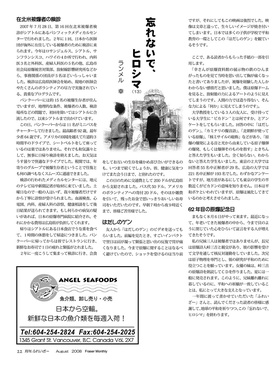
At a time when phrases such as “nuclear power,” “nuclear warheads,” and “radiation” appear in headlines almost on a daily basis, many survivors feel a sense of responsibility to speak about the human consequences of nuclear disasters. “Who else will if we don’t?” say many survivors who read news reports that portray the world as if it is on the verge of a nuclear war. Many survivors also feel as if they were “made to live,” because so many around them died as a result of the bomb. After suffering from numerous health problems caused by radiation, they are surprised that they are still alive. Many believe that it is a kind of calling for them to do something meaningful with their lives, that they have a role to fulfill. This sentiment fuels much of their antinuclear, peace activism.

*This article is an excerpt from Hiroshima Nagasahki Beyond the Ocean (2014) by Shinpei Takeda and Naoko Wake.
© 2104 Shimpei Takeda and Naoko Wake



